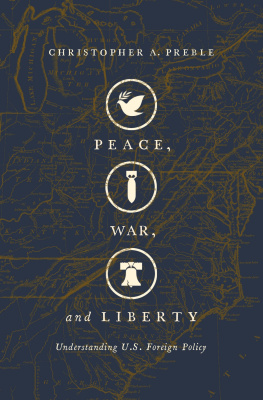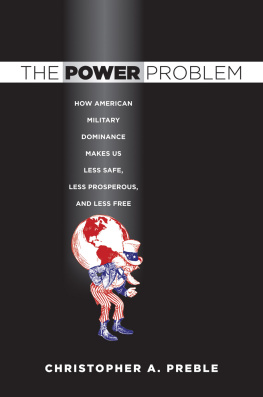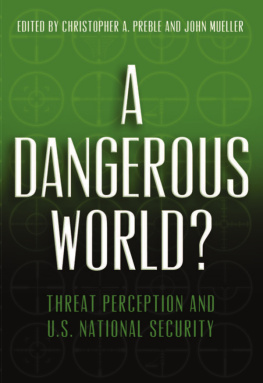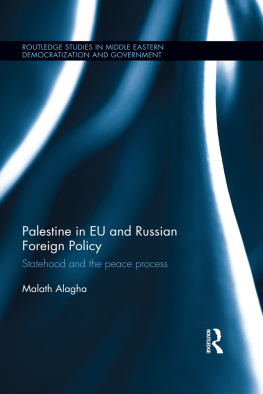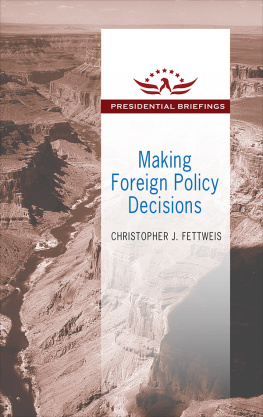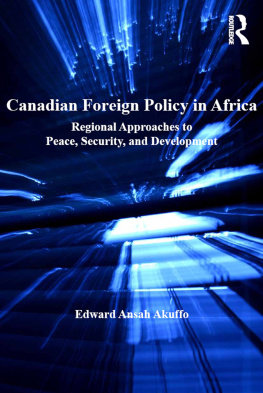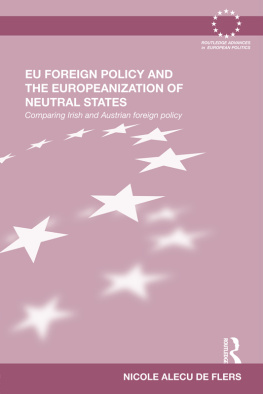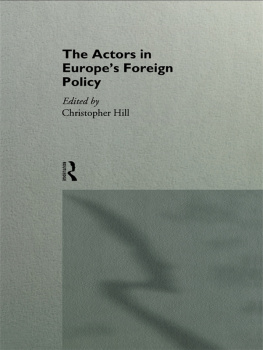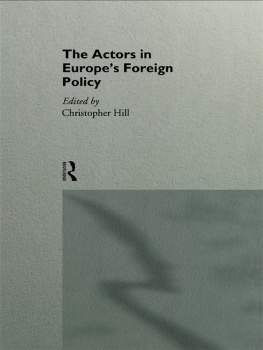Preface
This is a short book about a big topic: foreign policy. In the widest sense, a particular countrys foreign policy pertains to the myriad ways in which that countrys people engage and interact with people and institutions from other countries. The book focuses mainly on a particular class of people who have a particular responsibility for conducting a given countrys foreign policychiefly its elected officials, military personnel, and diplomats. These people establish and enforce the rules governing how the rest of their countrys people may or may not engage or interact with f oreigners.
Some of these laws are fairly innocuous and impose only minor or temporary inconveniences. For example, U.S. law prohibits me from purchasing or owning certain items covered by U.S. sanctions. If Im caught breaking the law, I could be p rosecuted.
Collectively, the drafting and enforcing of such regulations necessitates a large and relatively intrusive statelarger, say, than a state that allowed me to purchase any good or service, from any place, regardless of the circumstances of its production or provision.
But war, that most visible of all instruments of foreign policy, imposes major and oftentimes lasting effects on individuals lives an d liberty.
War today is often seen as a foreign policy failure, but it wasnt always that way. The famed Prussian military theorist Carl von Clausewitz described war as the continuation of policy by other means. Even militarily strong countries, however, would generally prefer to attain peacefully what could be secured by force. The reasons are fairly obvious and straightforward: War is unpredictable. War is costly. War is violent. Policymakers, therefore, should not embark on such a course lightly or with unrealistic expectations about quick success. Clausewitz spoke of friction, the fog of war, and how battle plans rarely survive first contact with the enemy. Winston Churchill, celebrated wartime leader, was similarly mindful of wars uncertainty. The Statesman who yields to war fever, he wrote in his memoir, My Early Life , is no longer the master of policy, but the slave of unforeseeable and uncontrollable events.
The liberals of Clausewitzs day, whom today we might call libertarians, had still more reasons for wanting to solve international problems by peaceful means. They knew that war often contributed to the rise of state power and therefore constituted a threat t o liberty.
This book approaches warfare as they did: as an occasionally necessary evil, not an endeavor that should be used as a vehicle for promoting social change. The book is organized around a theoryor, more accurately, a set of different theoriesabout what best creates security and p rosperity.
Simply, what causes peace? And relatedly, what can we do to advance individual liberty through peaceful means? In what instances, if any, is war the appropriate recourse? And what foreign policies other than war are more effective? This book addresses these questions.
Because I am an American, writing chiefly for an American audience, I will focus mostly on U.S. foreign policy. I believe that Americas founding generation, in particular, proposed a foreign policy broadly consistent with libertarian principles, favoring peaceful engagement through trade and cultural exchange and holding a skepticism of warfare as an instrument of policy. Despite this U.S.-centric approach, I believe that the book has insights for many people in many countries. Identifying the particular pathologies that have afflicted U.S. foreign policy over timefoolish wars fought well, noble wars fought badly, well-intentioned restrictions on travel or trade that had unfortunate side effects, alliances created or dissolvedsurely has relevance for other countries at ot her times.
The claim that U.S. foreign policy is like that of any other country comes with a crucial proviso: U.S. foreign policy is bigger a function of our great wealth and power. The scope of any one nations foreign policies is shaped by that nations physical context, including its geography, and by the disposition (i.e., friend or foe) of its neighbors. Scope is also constrained by a given countrys economic capacity to engage in all aspects of foreign policyfrom conducting diplomacy to w aging war.
Relatively small, relatively weak, or relatively poor countries must necessarily prioritize what they do. Medium- and large-sized countries also set priorities but can have more of them. Even relatively affluent countries often choose to privilege one aspect of foreign policy (e.g., trade) over another (e.g., war). Icelands defense budget is effectively zero, as is Costa Ricas. The United States began as a small, weak country. Its constitution forbade a standing army, and it struggled in its early days to deploy forces even into neighboring Canada or Mexico. Today, the United States possesses the worlds most powerful military. That vast force is capable of deploying in many places simultaneously and even performs many of the jobs that other countries assign solely to their diplomats.
This book proceeds in two parts. The first half explores the correlation between liberty and peace on the one hand, and illiberalism and war on the other, over the course of the last several hundred years. It begins by exploring how ideas about individual freedomand the role that wars have played in advancing or impeding those ideasevolved over time. It pays particular attention to the American experience, including especially the views of the Founders of the American republic, men such as George Washington, James Madison, and Thomas Jefferson, and their contemporaries and successors in the 18th and 19th centuries.
The American Founders had a clear vision for foreign policy. They established a set of criteria regarding foreign affairs, and fashioned a limited state to implement them. Those limits endured for more than a century. They advised against an ambitious and adventurous policy overseas that would necessitate large armies and naviesand a large state to support them. They believed that the costs and risks that such a state would pose to liberty were simply too great and that, from a practical perspective, the new nation was simply too small and weak to have much of an impact globally. They werent merely limited by their circumstances, however; they also consciously constrained their own power. They hoped to fashion a Novus Ordo Seclorum (A New Order of the Ages). They objected to the very principle of empire practiced by the kings and princes that came before them. The United States, they explained, would be different.
Part I, then, traces the seemingly inexorable transformation of U.S. foreign policy in the 20th century from that espoused by the American Founders to one constructed around the growth of the state, creeping militarism, and frequent wars. Dwight David Eisenhower, though he made a career in the U.S. Army, lamented how the military-industrial complex threatened to permanently change the nature of the country that he led and served. In one of the first speeches of his presidency, delivered in March 1953, Eisenhower explained that the United States had, of necessity, adopted a semipermanent war footing. By the time of his farewell address, delivered nearly eight years later in January 1961, Eisenhower worried that it might never be ro lled back.



